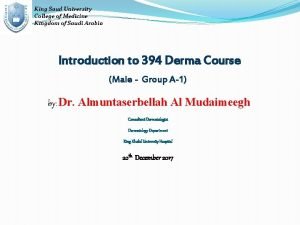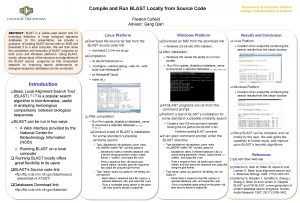UNIVERSITY OF ALQADISIYAH College Of Science Department Of












































- Slides: 44

UNIVERSITY OF AL-QADISIYAH College Of Science Department Of Bio. Chemistry Practical Analytical Chemistry First Year – Second Semester Prepared By Dr. hasan M. L. And MSc. Ebtsam K. 2017 – 2018

Quantitative Analysis Quantitative analysis relying on chemical reaction. is analysis which involves investigating the quantities or amounts of materials present. Gravimetric analysis composition of substances determined by careful weighing Volumetric analysis composition of substances determined by reacting together volumes of solutions

Quantitative analysis relying on chemical reaction divided to tow main parts: 1) Gravimetric analysis: Here the said substance is precipitated into insoluble from which is filtered, dried and weight is measured as a function of quantity. Ex: Barium sulphate + Sodium carbonate →Barium carbonate + Sodium sulphate. Here Barium sulphate is soluble and is converted to Barium carbonate an insoluble form by addition of sodium carbonate. The insoluble precipitate is weighed for the quantity of Barium ion in the given sample. 2) Titrimetric analysis : Here the volume of reagent required to complete the reaction with substance of interest is noted using reactions like acid-base neutralization, oxidationreduction, complex-forming or precipitation reactions. Ex: HCl + Na. OH → Na. Cl + H 2 O. Once the reaction reaches completion, end point is indicated by a change in colour of an indicator added in the reaction mixture .

THE TITRATION Introduction The word "titration" comes from the Latin "titalus, " meaning inscription or title. The French word, titre, also comes from this origin, meaning rank is a common laboratory method of quantitative/chemical analysis that can be used to determine the concentration of a known reactant (analyte). The basis of the method is a chemical reaction of a standard solution (titrant) with a solution of an analyte. The analyte (A) is a solution of the substance whose concentration is unknown and sought in the analysis. The titrant (T) is a solution in which the concentration of a solute is precisely known. Because volume measurements play a key role in titration, it is also known as volumetric analysis. Usually it is the volume of the titrant required to react with a given quantity of an analyte that is precisely determined during a titration.

Titration Notes ¨ Always rinse burette with water (from a beaker, not the faucet) first. Second, rinse with a small amount of the titrant and drain it through the tip. ¨ Fill the burette with the titrant using a funnel. ¨ Fill the burette tip by momentarily opening the stopcock. ¨ Now you are ready to read the initial volume (bottom of the meniscus). Remember that burets are graduated in a downward direction. The first estimated digit will probably be the hundredths place. ¨ Do not waste time trying to fill the burette to zero for each titration. ¨ Do not start above the 0 m. L mark or titrate past the 50 m. L mark. ¨ Always use white paper underneath your sample flask so that you will notice slight color changes. ¨ Learn to swirl the flask without removing it from underneath the burette. ¨ Use a drop, drop pace until you see the color change becoming more than local (where the titrant meets the sample). Now proceed dropwise. ¨ Second and third trial titrations should always be fast assuming the sample will be about the same because you now know approximately how much titrant is needed. If the first titration required 25 m. L than you can add 22 m. L all at once and then proceed cautiously. ¨ Remember that the amount of water used to dilute the sample is not crucial because it does not affect "how many" of the sample molecules are present in the sample flask. Diluting with water allows you to see the color change easier. ¨ Always label multiple burets and sample flasks. ¨ Remember to add indicator.

Types of titration Titration Reaction types 1) Acid-Base Titrations 2) Redox titrations 3) Complexometric titrations 4) Zeta- potential Tittrations 5) Miscellaneous titration 6) Iodimetry titration 7) Precipitation titration 8) Kjeldahl Titration 9) Argentometric Titrations 9. 1) The Mohr titration: 9. 2) Volhard titration 9. 3) Fajans titration 10) Classification of titration by end-point techniques 10. 1) Conductometric titration 10. 2) Potentiometric titration 10. 3) Spectrophotometric titration 10. 4) Amperometric titration 10. 5) Thermometric or enthalpimetric titration 10. 6) Nonaqueous titration 10. 7) Automatic titration 10. 8) electrochemical titration 11)Back titrations 12)Virus titration Titrimatery types: 1) volumetric titrimetry 2) gravimetric or weight titrimetry 3) Coulometric titrimetry 4) standardization

1) Acid-Base Titrations: Titration is a process of neutralization whereby a titrant (a solution of known concentration) is delivered into an analyte (unknown solution) until the unknown solution is completely neutralized. This will allow information about the unknown solution to be determined. An indicator is (often) a weak acid that is placed into the unknown solution to determine the endpoint of the titration (the p. H at which the indicator changes color). The equivalence point of the titration is the point when the moles of H+ are equal to the moles of OH- in a titration. The progress of an acid-base titration is often monitored by plotting the p. H of the solution being analyzed as a function of the amount of titrant added. The graph produced is called a titration curve. Types of acid-base Titrations : (i) Strong Acid / Strong Base: p. H at equivalence point = 7 (ii) Weak Acid / Strong Base: p. H at equivalence point >7 (iii) Strong Acid / Weak Base: p. H at equivalence point <7 *Note: weak acid / weak base titrations are too complicated and are almost never carried out.

Choosing indicators for titrations Remember that the equivalence point of a titration is where you have mixed the two substances in exactly equation proportions. You obviously need to choose an indicator which changes colour as close as possible to that equivalence point. That varies from titration to titration.

Strong acid v strong base The next diagram shows the p. H curve for adding a strong acid to a strong base. Superimposed on it are the p. H ranges for methyl orange and phenolphthalein. You can see that neither indicator changes colour at the equivalence point. However, the graph is so steep at that point that there will be virtually no difference in the volume of acid added whichever indicator you choose. However, it would make sense to titrate to the best possible colour with each indicator. If you use phenolphthalein, you would titrate until it just becomes colourless (at p. H 8. 3) because that is as close as you can get to the equivalence point. On the other hand, using methyl orange, you would titrate until there is the very first trace of orange in the solution. If the solution becomes red, you are getting further from the equivalence point.


2) Red-ox titrartion: Titration of a reducing agent by an oxidizing agent or titration of an oxidizing agent by a reducing agent. The concentrations of redox-active species can be determined by redox titrations. In a redox titration, a measured sample of the unknown is titrated against a standard solution of a substance that will oxidize or reduce the unknown. Red-ox reaction: A redox reaction (reduction and oxidation reaction) is a reaction in which there is a transfer of electrons. When an element is reduced, it gains electrons and its oxidation number is reduced. When an element is oxidized, it loses electrons and its oxidation number increases. Reduction and oxidation always happen at the same time. Key points about Red-ox titration: • A REDOX titration is a volumetric method that relies on the oxidation of the analyte (substance to be analyzed). • The titrant (solution of known concentration) is often an oxidizing agent. Common oxidizing agents are: Permanganate anion (Mn. O 4 -) and Dichromate anion (Cr 2 O 7 -2).

4) Argentometric Titrations: Titrimetric methods based on silver nitrate are sometimes called argentometric methods. 4. 1) The Mohr titration: In this method Sodium chromate can serve as an indicator for the argentometric determination of chloride, bromide , and cyanide ions by reacting with silver ion to from a brick-red silver chromate precipitate in the equivalence –point region. 4. 2) The Fajan titration: In this method a coloured indicator is absorbed onto the precipitate at end point . Absorption indicator is an organic compound that tends to be adsorbed onto the surface of the solid in a precipitation titration. the adsorption occurs near the equivalence point and results not only in a color change but also in a transfer of color from the solution to the solid. Fluorescein is a typical adsorption indicator that is useful for the titration of chloride ion with silver nitrate. 4. 3) Volhard titration: Determination of the halogen content of a solution by titration with a standard thiocyanate solution. 5) Back titrations: are like normal titrations, except that a known excess of a standard reagent is added to the solution being titrated. The solution is then titrated back, taking into account the addition of the excess. Back titrations are useful if the end point of the reverse titration is easier to identify than the end point of the normal titration.

Titrimetry types: Titrimetry: measuring the quantity of a reagent of known conc required to react with a measured quantity of sample of an unknown con. (i) Volumetric Titrimetry involves measuring the volume of a solution of known concentration that is needed to react essentially completely with the analyte. (ii) Gravimetric Titrimetry differ only in that the mass of the reagent is measured instead of its volume. (iii) Coulometric Titrimetry : The reagent is a constant direct electrical current of known magnitude that consumes the analyte the time required and thus the total charge to complete the electrochemical reaction is measured. Types of Titration Curves: Graph showing variation of concentration (or something proportional to concentration such as absorbance of light, voltage, or conductance) vs. volume of titrant added There are some titration curves used in complete description of titration Titration Curves are plots of a concentration-related variables as a function of reagent volume. Concentration change is large—use p function p. X = -log 10[X] (i) Sigmoidal curve: p-function of analyte (or sometimes the reagent) is plotted as a function of reagent volume. (ii) Linear segment curve: measurement are made on both sides of but well away from the equivalence point. (advantageous for reaction that are complete only in the presence of a considerable excess of the reagent or analyte)


Volumetric Analysis - Titrations Definitions: Standardize: means to find the concentration of a solution using titration A Titration: is a laboratory procedure where a measured volume of one solution is added to a known volume of another solution until the reaction is complete. Equivalence Point (End Point): the stage when the two solutions just react completely with each other

Standard Solutions Definition: A standard solution is a solution whose concentration is accurately known e. g. a solution containing 10 grams of Na. Cl per litre is a standard solution In the determination of the concentration of an acid a standard solution of an alkali is used and to determine the concentration of an alkali a standard acid would be used. However, before any determinations can be made a starting accurately standardised solution is required – from which to find the exact concentration of other solutions

A standard solution is prepared by weighing out a sample of solute, transferring it completely to a volumetric flask, and adding enough solvent (usually deionised water) to bring the volume up to the mark on the neck of the flask.

Due to the fact that many substances can not be obtained in a high degree of purity standard solutions of common laboratory acids and bases cannot be prepared directly e. g. : - cannot weigh out 1 mole of sulphuric acid as it absorbs moisture from the air - cannot weigh out 1 mole of nitric acid as it is volatile - cannot weigh out 1 mole of iodine as it sublimes at room temperature In order to make up standard solutions substances which can be obtained in a highly pure state and which are stable in air are required

Primary Standard Definition: A primary standard is a substance which can be obtained in a stable, pure and soluble solid form so that it can be weighed out and dissolved in water to give a solution of accurately known concentration Primary Standard Solution = Pure 100% Soluble Stable once made up Examples of Primary Standards: - Anhydrous sodium carbonate Na 2 CO 3 - Sodium Chloride Na. Cl - Potassium Dichromate K 2 Cr 2 O 7

Secondary Standard Make up a solution and then standardise this solution using a primary standard. This secondary standard can then be used to standardise other solutions e. g. HCl standardised and then used to standardise Na. OH

Volumetric Analysis Calculations 1. Calculating the unknown concentration of a solution from titration data 2. Calculating the relative molecular mass and the amount of water of crystallisation in a compound from titration data.

1. Calculating the unknown concentration of a solution from titration data In straight forward titration calculations, where only the unknown concentration is required, the following formula can be used: VA x M A n. A = VB x M B n. B VA = volume (cm 3) of acid used MA = concentration of acid n. A = no. of moles of acid in balanced eqn for rxn VB = volume (cm 3) of base used MB = concentration of base n. B = no. of moles of base in balanced eqn for rxn

Example 1: In a titration, 25 cm 3 of a 0. 05 M sodium carbonate solution required 22 cm 3 of a hydrochloric acid solution for complete neutralisation. Calculate the concentration of the hydrochloric acid solution. The equation for the reaction is: 2 HCl(aq) + Na 2 CO 3(aq) 2 Na. Cl(aq) + H 2 O(l) + CO 2(g)

Example 2: Sodium carbonate, Na 2 CO 3, reacts with dilute hydrochloric acid according to the equation: Na 2 CO 3 + 2 HCl → 2 Na. Cl + CO 2 + H 2 O What volume of hydrochloric acid of concentration 0. 75 M would be needed to neutralise 7. 5 g of anhydrous sodium carbonate?

Example 3: Hydrochloric acid and sodium hydroxide react according to the equation: HCl + Na. OH Na. Cl + H 2 O 25 cm 3 of a sodium hydroxide solution was titrated against a 0. 2 M HCl solution. The average titration figure was 23. 5 cm 3. Calculate the concentration of the sodium hydroxide solution in: a) mol/L b) g/L

Using results from your experiment calculate the concentration of the given hydrochloric acid solution in mol/L and g/L *Note: The first titration you performed was a rough titration which gave you an idea of where the end point is and so this result should be neglected. The remaining two titration results should agree within 0. 1 cm 3 of each other. The average of these results should be used in your calculation of the concentration of HCl.

Example 4: 1. 45 g of sodium carbonate was dissolved in water and the solution was made up to 250 cm 3 in a volumetric flask. 25 cm 3 of this solution were titrated against a solution of hydrochloric acid using methyl orange as indicator. One rough and two accurate titrations were performed. The titration results and the equation for the reaction are given below. What is the concentration of the HCl solution in a) mol/L b) g/L Titration 1 2 3 Volume Acid (cm 3) 19. 8 19. 5 19. 6 2 HCl(aq) + Na 2 CO 3(aq) 2 Na. Cl(aq) + H 2 O(l) + CO 2(g)

Example 5: 10. 0 g of impure sodium hydroxide were weighed out, dissolved in water and solution made up to 250 cm 3 in a volumetric flask. 25 cm 3 of this solution, on being titrated with 1. 1 M HCl, required 21. 8 cm 3 of the acid for neutralization. Calculate the % purity of the original sodium hydroxide.

In a calculation involving a standard solution where more than just the unknown concentration is required, or where a solid is one of the reactants an alternative method from first principles should be used. Example 6: In a titration, 25 cm 3 of a 0. 12 M Na. OH solution required 24 cm 3 of a H 2 SO 4 solution for complete neutralisation. Calculate: i) the number of moles of Na. OH consumed ii) the number of moles of H 2 SO 4 consumed iii) the concentration of the H 2 SO 4(aq) + 2 Na. OH(aq) → Na 2 SO 4(aq) + 2 H 20(l)

Example 7: What mass of magnesium will react with 20 cm 3 of a 0. 09 M hydrochloric acid solution? The equation for the reaction is: 2 HCl(aq) + Mg(s) → Mg. Cl 2(aq) + H 2(g)

Example 8: A sample of vinegar was diluted from 25 cm 3 to 250 cm 3 with water. In a titration, 25 cm 3 of a 0. 1 M Na. OH solution required 30 cm 3 of the diluted vinegar for complete neutralisation. Calculate the concentration of ethanoic acid (CH 3 COOH) in the vinegar in: i) mol L-1 ii) g/L iii) %w/v The equation for the reaction is CH 3 COOH(aq) + Na. OH(aq) → CH 3 COONa(aq) + H 2 O(l)

Experiment NO. 1 Preparation of 0. 1 N Hydrochloric Acid (Secondary Standard) and its standardization with Sodium Carbonate (Primary Standard). EXP. NO. 1 2 3 Initial Reading (V 1) Final Reading (V 2) Difference V 2 -V 1

Experiment NO. 2 Preparation of 0. 1 N Sodium Hydroxide and its standardization with standard HCl solution EXP. NO. 1 2 3 Initial Reading (V 1) Final Reading (V 2) Difference V 2 -V 1

Experiment NO. 3 Standardization of HCl using standard solution of sodium carbonate then determination of concentration of sodium hydroxide and carbonate sodium in mixture (Neutralization Reaction) Standardization of HCl using standard solution of sodium carbonate 1 - Aim: Calculate N (HCl) 2 - Theory: HCl + Na 2 CO 3 → Na. Cl + Na. HCO 3 p. H = 8. 7 HCl + Na. HCO 3→Na. Cl + H 2 CO 3 p. H = 3. 7 3 - Chemical : HCl (0. 1 N), Na 2 CO 3 (0. 1 N), ph ph and MO 4 - Apparatus: Conical flask & burette & Pipitte & Beaker 5 - Procedures: a- Transfer 10 m. L Na 2 CO 3 solution into C. F. b- Add 2 -3 drops of ph ph (pink color) c- Titrate using HCl till (colourless)

6 - Calculation: (N x V) HCl = (N x V) Na 2 CO 3 Note: in case ph ph V HCl = 2 V of burette In case MO V HCl = V of burette Repeat the above steps with MO EXP. NO. 1 2 3 Initial Reading (V 1) Final Reading (V 2) Difference V 2 -V 1

Experiment NO. 4 Determination of ammonia using standard solution of HCl 1 - Aim: calculate NNH 3 2 - Theory: NH 4 Cl + (Na. OH)excess = Na. Cl + (Na. OH)unreacted remained + NH 4 OH Then boil the total solution to liberate NH 4 OH as ammonia gas then titrate against HCl Note: NH 3 is volatile gas so determination of ammonia will be using indirect titration (back titration) Back titration is suitable in these cases: 1) Volatile compounds 2) When the sample is solid or insoluble 3) When a large excess of reagent be needed 4) When we need boiling 3 - Procedure: 1) Transfer 10 ml ammonia solution in to C. F. 2) Add 30 ml Na. OH 3) Boiling for about 15 min. 4) Cool then add 2 -3 drops of MO 5) Titrate against HCl till red

4 - Calculate: VHCl = unreacted Na. OH Reacted Na. OH = 30 – VHCl(unreacted Na. OH) (N x V)Na. OH = (N x V)NH 4 Cl 0. 1 x (30 – VHCl) = N x 10 EXP. NO. 1 2 3 Initial Reading (V 1) Final Reading (V 2) Difference V 2 -V 1

Experiment NO. 5 Determination the percentage of ethanoic acid (acetic acid) in vinegar 1 - Aim: Calculate % HAC IN vinegar. 2 - Theory: In this experiment, a standardized sodium hydroxide solution (Na. OH) will be used. Using basic stoichiometry, the moles of acetic acid (CH 3 COOH) in the vinegar solution can be determined from the moles of Na. OH added to the reaction. CH 3 COOH + Na. OH ―› CH 3 COONa + H 2 O Note: the molar relationship. For every one mole of acetic acid, it would take one mole of Na. OH to completely react it. For every one mole of Na. OH, it takes one mole of acetic acid to react with it. Moles of Na. OH = Moles of CH 3 COOH In the titration, the Na. OH is added drop-by-drop using the burette. The burette indicated how much Na. OH is being added to the vinegar solution. At the point where all the acetic acid in the vinegar solution has been reacted (endpoint) any additional Na. OH will turn the solution basic. The indicator, phenolphthalein, in a basic solution turns the solution from clear to pink at this point. The volume of Na. OH added to the vinegar solution is read off the burette in milliliters and converted to liters (liters = ml / 1000) The moles of the sodium hydroxide used to react with the acetic acid in the vinegar solution can now be determined. Moles of Na. OH = Molarity of Na. OH X Litres of Na. OH

3 - PROCEDURES A) PREPARATION OF BURETTE 1. Clean a 50 ml burette and rinse with DI water. A clean burette will have no droplets clinging to inside of the glass. 2. Rinse the burette with two 5 ml portions of the standardized Na. OH solution. Make sure you drain the Na. OH solution through the tip of the burette. 3. Using a funnel, fill the burette with the standardized Na. OH solution. Make sure that the tip is also filled and there are no air bubbles in the tip. 4. Slowly drain the Na. OH out of the burette until the burette reads 0. 0 ml. Read from the bottom of the meniscus. It is sometimes helpful to hold a piece of paper with a black line behind the burette and line it up with the meniscus. B) PREPARATION OF THE VINEGAR SOLUTION 5. Pipet 5 ml of the vinegar solution into a clean 250 ml flask. 6. Add 50 ml of DI water to the flask. 7. Add two drops of phenolphthalein indicator. C) DETERMINATION OF % ACETIC ACID IN A VINEGAR SOLUTION 8. Place a white background underneath the flask with the vinegar solution. 9. Slowly add with constant swirling the Na. OH drop wise to the vinegar solution. 10. Continue adding drop wise to the vinegar solution until the vinegar solution turns the faints shade of pink that remains for 30 seconds. This is called your endpoint. 11. Calculate the % by mass of acetic acid in the vinegar solution.

EXP. NO. 1 2 3 Initial Reading (V 1) Final Reading (V 2) Difference V 2 -V 1

Experiment NO. 6 Standardization of potassium permanganate using oxalic acid (Reduction-Oxidation Reaction) 1 - Aim: Calculate NKMn. O 4 2 - Theory: KMn. O 4 is a 2 nd standard substance KMn. O 4 + C 2 O 4 H 2 + H 2 SO 4 = K 2 SO 4 + Mn. SO 4 + CO 2 + H 2 O Conditions for KMn. O 4 titration: 1 - Acidic medium using 20 ml 2 N H 2 SO 4 2 - Heating to 70 ◦C 3 - Procedures 1) Transfer 10 ml oxalic or oxalate soln. in to C. F. 2) Add 20 ml 2 N H 2 SO 4 3) Heat to 70 ◦C 4) Titrate with KMn. O 4 gradually with stirring till pink 5) Calculate (N x V)KMn. O 4 = (N x V)oxalic

EXP. NO. 1 2 3 Initial Reading (V 1) Final Reading (V 2) Difference V 2 -V 1

Experiment NO. 7 Silver nitrate titrations by Mohr method (precipitation titration) 1 - Aim: Calculate NCl- or NBr 2 - Theory: Na. Cl (soln. ) + Ag. NO 3(titrant) = Ag. Cl(white ppt. ) + Na. NO 3 At the end point: Ag. NO 3(titrant) + K 2 Cr. O 4 = KNO 3 + Ag 2 Cr. O 4(red ppt. ) 3 - Chemicals: Ag. NO 3 (0. 1 N), Na. Cl (unknown), K 2 Cr. O 4 (Indicator) 4 - Procedure: 1 - Transfer 10 ml of Na. Cl solution in C. F. 2 - Add 3 drops of chromate indicator p. H(6. 5 -9) 3 - Titrate against 0. 1 N Ag. NO 3 (white ppt. is formed) 4 - At end point the excess of Ag. NO 3 will react with Ind. To form red ppt. 5 - Calculations: (N x V)Na. Cl = (N x V)Ag. NO 3

EXP. NO. 1 2 3 Initial Reading (V 1) Final Reading (V 2) Difference V 2 -V 1
 Mice.cs.columbia
Mice.cs.columbia 沈榮麟
沈榮麟 Salahaddin university college of education
Salahaddin university college of education Economics … my favorite subject at school
Economics … my favorite subject at school Pasadena city college police department
Pasadena city college police department Department of law university of jammu
Department of law university of jammu Department of geology university of dhaka
Department of geology university of dhaka University of padova psychology department
University of padova psychology department University of bridgeport it department
University of bridgeport it department Isabel darcy
Isabel darcy Sputonik
Sputonik Texas state university psychology
Texas state university psychology Department of information engineering university of padova
Department of information engineering university of padova Information engineering padova
Information engineering padova Manipal university chemistry department
Manipal university chemistry department Syracuse university psychology department
Syracuse university psychology department Jackson state university finance department
Jackson state university finance department Michigan state physics
Michigan state physics Columbia university cs department
Columbia university cs department University of sargodha engineering department
University of sargodha engineering department Stanford university philosophy department
Stanford university philosophy department Graham roberts ucl
Graham roberts ucl Electrical engineering northwestern
Electrical engineering northwestern Computer science department rutgers
Computer science department rutgers Department of forensic science dc
Department of forensic science dc Oh.nesinc
Oh.nesinc Vptl tutoring stanford
Vptl tutoring stanford Florida state university cs faculty
Florida state university cs faculty Trimentoring
Trimentoring Department of computer science christ
Department of computer science christ Eacademics iitd ac in sportal login
Eacademics iitd ac in sportal login Asd college college readiness program
Asd college college readiness program Early college high school at midland college
Early college high school at midland college Types of tourists
Types of tourists Stranmillis university college
Stranmillis university college Norwegian police university college
Norwegian police university college Lincoln memorial university college of veterinary medicine
Lincoln memorial university college of veterinary medicine King saud university college of medicine
King saud university college of medicine King saud university college of medicine
King saud university college of medicine King saud university college of medicine
King saud university college of medicine University of iowa college of dentistry
University of iowa college of dentistry Clark university college board
Clark university college board Artesis plantijn university college of antwerp
Artesis plantijn university college of antwerp Norwegian defence university college
Norwegian defence university college King saud university college of pharmacy
King saud university college of pharmacy



































































